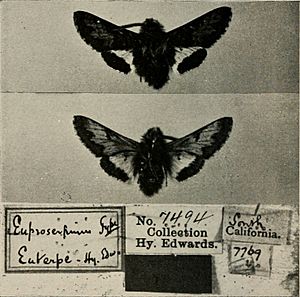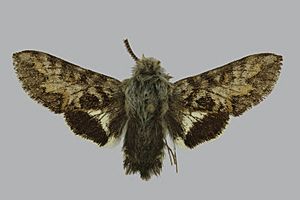Kern primrose sphinx moth facts for kids
Quick facts for kids Kern primrose sphinx moth |
|
|---|---|
 |
|
 |
|
| Conservation status | |
| Scientific classification | |
| Genus: |
Euproserpinus
|
| Species: |
euterpe
|
The Kern primrose sphinx moth (scientific name: Euproserpinus euterpe) is a small, special kind of moth. It flies during the day, which is unusual for many moths! It belongs to the Sphingidae family, also known as sphinx moths.
These moths lay tiny, light green eggs (about 1 millimeter big). They often lay them on or near evening primrose plants. These plants are the main food for the baby moths. The eggs hatch into larvae (caterpillars) about a week later. The caterpillars then start munching on the flowers and young leaves of the evening primrose. If an egg is laid on another plant, the tiny caterpillar can crawl quite far to find its favorite food plant.
Contents
Life Cycle and Appearance
The Kern primrose sphinx moth goes through several stages as it grows. This is called its life cycle.
Caterpillar Stages
When the caterpillars first hatch, they are called first-instar larvae. They are green with dark brown or black heads and legs. They also have special spots called spiracles (for breathing) and a blunt horn at their rear end.
As they grow, they shed their skin. Second- and third-instar larvae become green and red. Their heads, chests, and prolegs (special leg-like parts) turn red.
Older caterpillars (fourth- and fifth-instar larvae) have red or dark red heads. Their bodies are a mix of green and rust-red. They have black areas around their spiracles and a black horn. Their true legs are green, and their prolegs are red.
Adult Moth Appearance
Adult Kern primrose sphinx moths are mostly gray. They have cool black and brown patterns on their front wings. Their back wings are off-white with black bands along the edges.
Male moths are a bit smaller than females. It's hard to tell them apart without looking closely at their antennae. These moths are quite small, with a wingspan of just over an inch (about 25 millimeters) from wingtip to wingtip.
What They Eat and When They Fly
Adult Kern primrose sphinx moths drink nectar from many different flowers in their area. Some of their favorite flowers include filaree, goldfields, and baby blue eyes.
You can usually see these moths flying from mid-January to early April. They are most active in mid-February through mid-March. The exact timing can change a bit depending on the weather.
Where They Live
The Kern primrose sphinx moth is very rare. It is only found in two places in California.
One place is a private ranch in the Walker Basin in Kern County. This area is mostly used for farming, like growing grains and raising cattle. The moths like disturbed areas there, especially sandy banks of dry creek beds called washes. The sand in these washes is just right for the caterpillars to burrow into. They can also be found along road shoulders and in old farm fields.
The other place is the Carrizo Plain National Monument in San Luis Obispo County. This population was found in 2002. The land here is managed by the Bureau of Land Management to help protect these moths.
Why They Need Our Help
The Kern primrose sphinx moth is a very rare species. It needs our help to survive.
For a long time, people thought a plant called Erodium was a big problem for the moths. They thought female moths laid eggs on it by mistake, and the caterpillars would die. But new research shows that female moths lay eggs on many plants. The caterpillars then just wander off to find the right food plant, which is the evening primrose. They never eat Erodium.
This moth was even thought to be extinct until 1974! That's when a living group was found in Kern County.
There are a few things that can threaten these small moth groups:
- Collectors: Some people like to collect insects, and rare moths like these can be very valuable. This can harm small populations.
- Pesticides and Herbicides: Chemicals used to kill pests or weeds can also hurt or kill the moths.
- Habitat Loss: The biggest threat is losing their natural homes. When land is developed or changed, the moths lose the plants they need to survive.
Because they are so rare, scientists often find very few moths during surveys, especially in dry years. However, desert insects often have populations that go up and down a lot depending on the weather. So, more moths might be seen in years with more rain. Protecting their habitat is key to helping them survive.


